|
| All
of Texas is divided into three parts. One of which, the neo-modern
urbanizations, where the glass, concrete and steel agoras offer a
majority the communion we have grown accustomed to, the one most of
us are familiar with. Another, the grassy, hoary rural communities,
where cars wave to each other on passing regardless of familiarity,
where pre-dawn farm reports, feed stores and fishing are still a daily
routine, are known to most of us either from childhood, stories or
occasional Sunday drives. And finally, of course, those areas of the
state which find themselves awkwardly straddling the aged fence between
these two realities; those towns where the polis is attempting to
envelope the pastoral with its shining new tendrils, promising fortune
and prosperity in return for submission. Progress, as it is termed
now, has motored into so many of our smaller communities that it is
sometimes difficult to recognize the towns of our parents or grandparents,
harder still to recall the images as they were- at times only the
memory of details defines fact from obscurity. |
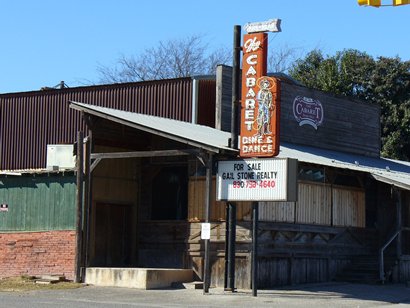 |
|
Such is the
case with the hill country town of Bandera.
Founded sometime around 1853, the town (self-described as the “Cowboy
Capital of the World”) has been home to several dance-halls and
dude ranches through the years for service men and women from San
Antonio as well as tree starved city dwellers from all over
the country. However, while the population is still advertised at
a meager 972, the beauty of the area attracts thousands of tourists
and “winter Texans” every year. The appeal of the region seems only
to increase as time moves forward. It seems strangely natural that
urban growth is matched, exponentially, by an increase in desire
for what it has replaced. Many towns throughout the country, once
rural enclaves, are changing to accommodate an ever swelling population.
Bandera is a community that illustrates this juxtaposition perfectly,
although the town teems annually with a transient populace. The
town does keep one large boot solidly planted in its agrarian past
but, the other is loping forward with enough enthusiasm to drag
both into relative modernity.
On
an unusually warm January morning, my wife and I left Austin
and drove southwest. We were to meet my father, a semi-retired doctor
of optometry who spent his adolescent years in Bandera
after leaving Houston
when he was twelve years old. He was to be our expert on things
“Hill Country”.
Although my father only lived in the community for eight years,
he still recalls that time with ardent affection and continues to
refer to the area as his home. In fact, when he chose to sell his
office and the need for population was no longer too important a
consideration, it was into Boerne,
just 45 minutes from Bandera
that he and his wife settled.
Driving west along highway 46, my wife commented on the beauty of
the real hill country. Austin,
our home, being just the edge of this unique geology, affords us
only a tantalizing, tangent view of the best scenery this side of
Big Bend. The views are magnificent and clearly, this expanse is
one of the reasons why so many Texans are so endeared with their
state.
Ever since I can remember, my father has frequently commented on
the way the hill
country has changed. When I was a teenager though, I thought
these constant comments were the standard opining of the middle-aged.
During the few times that we visited the region then, I could never
quite make out what, if anything, had changed from any previous
time. The relatives always had the same unhurried manner, the deer
were always in the road or lurking just off it and we always had
to allow for the fact that water wasn’t a seemingly inexhaustible
resource but rather, a very finite commodity that was literally
bubbling up from a well just outside. For an adolescent living in
the Dallas metroplex,
any environment that did not have restaurants and gas stations every
few yards was considered “the country”. An unpaved road was an anomaly.
Opinions, of course, like landscapes, are subject to change with
time.
|
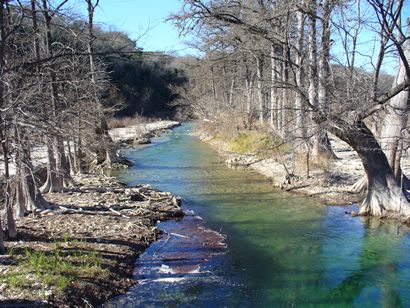 |
| We,
that is, my wife, dad, stepmother and myself, entered Bandera
on a Sunday afternoon from highway 16, a rolling, meandering two-lane
road that has obviously been broadened to accommodate the increase
in traffic. In fact, the construction is still underway. Even the
tiny community of Pipe Creek, a few miles outside of Bandera,
was busy with road and sewage construction when we drove through it.
(“There used to be nothing out here. Nothing!” my step-mother was
drawn to say as we drove past.) The main street in Bandera
itself was littered with the highway department’s orange and white
hurdles. However, my father, without a word regarding where he was
taking us, rolled straight through the heart of town and headed farther
west over a poetry inspiring fork of the Medina river and up a high,
steep hill to the ruins of the Silver Spur Dance Hall. |
Ruins of the
Silver Spur Dance Hall.
Photo courtesy Byron
Browne, December 2007 |
|
Several years
ago, while on a scholarship in Greece, an archaeologist told the
group I was in an old adage concerning archaeological sites-“If
you raise a couple of columns, the tourists will come!” Obviously,
the maxim holds true in Texas also. The shell of the old dance hall,
a cypress enveloped temple, still rests on a hill overlooking some
of the most gorgeous scenery anywhere in the state. In fact, the
ruin stands, sentinel like, keeping watch over the whole of the
town below. The building itself, roofless now, its white, stone
walls tenaciously weathering the years, is an architectural wonder.
I was immediately aware of why my father had wanted us to see this.
It resembles a Vanderbilt mansion more than a dance hall and must
have been exceedingly impressive when fully functioning. Not far
removed though are a few rental cottages. While I’m sure that a
stay in one of these would be a great experience, I was struck with
the same uneasy feeling as when I heard of a rock band playing inside
the Roman Coloseum-wouldn’t the traffic and vibration somehow damage
the site? ( I understand that comparing the Coloseum with the Silver
Spur Dance Hall is quite a stretch, even laughable, however, each
culture creates its own antiquities and we are all responsible for
the curation our own histories.) Nevertheless, the cottage’s website
states that, at least, there is no smoking. Oh, and you can have
your Yoga class there if you give enough notice of the intent.
As we left and went back down the road, my father told us how, as
a young man, he had so often, “made this trip drunk, sober and even
backed down it one night.” I asked him what condition he had been
in while descending the hill backwards. He replied, “Frightened!”
Back in town, we decided that we needed lunch and my father, although
no one in the car was or is disabled, pulled in to the first handicapped
parking space that he could find. (It was the sole spot available
on the main street for several blocks.) At first, I was shocked
by his temerity and disregard of law-after a moment I realized his
motivation. We were in Bandera
on a Sunday afternoon, a day of the week when hundreds of other
folks from all over central Texas had had the same idea. We were
surrounded by dozens of shiny new trucks, expansive SUVs and belching
Harley Davidsons, all of which seemed to be in search of that famous
Texan hospitality rather than offering any of it up themselves.
I assumed my father was behaving in accordance with the circumstance
and, while not physically handicapped, I further assumed that he
considered walking to lunch from blocks away disabling enough to
justify his decision. In any event, we parked and began to push
our way through the crowded, narrow sidewalks of the old town. Initially,
we tried to enter the OST, or Old Spanish Trail restaurant (established
1921) but, customers were already leaking out onto the sidewalk
at a little after noon. We eventually found a BBQ spot down the
sidewalk and very nearly enjoyed a Styrofoam-plated lunch of ribs,
ham and chopped beef. Where this restaurant had been only half full
when we entered, when we left, there was not an open table. Several
people were standing, drinks in hand, sending smaller family members
out into the dining room for reconnaissance work. We had to squeeze
through a small throng just to exit.
|
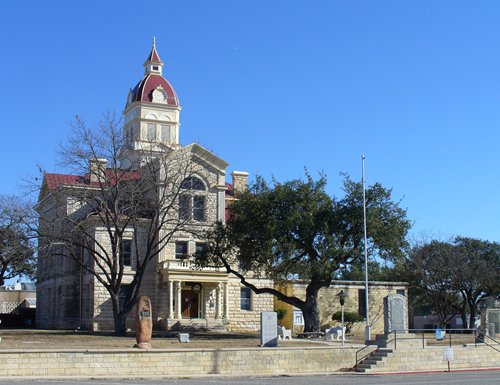 |
My father suggested
that I get a picture of the
courthouse because, quite obviously, as they are in most smaller
Texas towns, the courthouse
is the focal point of the downtown community. While the structure
seems to have been remodeled recently, the general architecture is
that of most of those from the same time period, a multi-storied nineteenth
century Norman Bates’ home looking structure but much better maintained
and without the dark dreariness and resident insanity. (although I’m
sure some would dispute the insanity statement. Isn’t the Bandera
courthouse where Nicole Richie and Paris Hilton “worked” during
one week of their old television show?) In order to get a decent picture
though, I needed to cross the street since we parked, legally this
time, directly in front of the building. So, while the remainder of
the party stayed in the car, I tried as best I could to hurry across
and get the shot. The traffic that afternoon was so constant you would
have thought funeral processions were passing from either direction.
I’ve waited shorter periods of time for pizza to be delivered. Honestly,
I think I was just feeling ridiculous; standing on the curb, camera
in hand, family peering at me, waiting from behind tinted glass while
I stood, and stood, and stood. Eventually, I did get across but, the
whole time I was wondering how long it might take to get back.
Afterwards, we drove to the Bandera Middle School, that was the high
school when my father lived there. The original building has been
incorporated into the existing school, an asset to the entire complex
as far as my father is concerned. Now, of course, the original building
is surrounded by many more modern structures and has the requisite,
adjoining athletic fields and parking lots. My father noted how the
earlier building, with its functioning furnace, housed all the grades
back in the forties and fifties. Pointing to the furnace’s smoke stack
he related how, during the winter months, the first student in to
school was responsible for lighting the day’s fire-a chore many kids
were more than willing to accept. “First one in in the mornings lit
the fire in the furnace”, he started then added, “’Course, being first
also meant you got to sit by the fire! It also meant you had a seat
for the day.” As a school teacher myself, I imagined the relish some
kids would take today given such an opportunity. (On the other hand,
there would also be the ever-present opportunity for the old, “I lost
my homework in the fire!” excuse.)
That afternoon we visited many areas that my father wanted to show
us to illustrate both his own and the town’s past history. We took
a quick tour of the Mayan Dude Ranch, a 340 acre ranch with individual
rock cottages as well as regular rooms for rent, and noticed that
the place was without a vacancy. The Mayan’s website states that,
”There is a ‘rootin’-tootin’ cowboy somewhere inside all of us,” and
dozens of folks were there riding horses trying to jostle that spirit
to consciousness. |
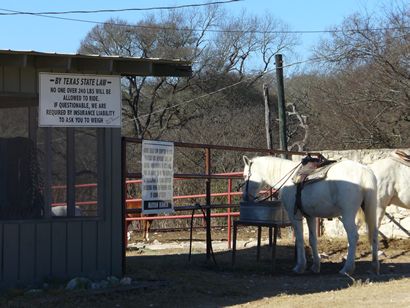 |
Mayan Ranch horses
Photo courtesy Byron
Browne, December 2007 |
We drove north
on highway 173 to Camp
Verde of camel
fame. The “General Store” of the old army base is all that remains
today. The buildings comprising the actual base, a mile from the store
and decommissioned by the army in 1869, were destroyed by a fire in
1910, several years after all the camels had been sold to a circus.
However, the most telling and indeed, most emotional aspect of the
trip, for myself at least, was still in Bandera
itself and just down the main street from the historical area.
In the late 1970’s my father took me dove hunting just outside of
Kerrville. We
stayed with a cousin of his and his family (most of whom still live
in the area). Along the way we passed, quite deliberately, through
Bandera-my
first visit to the town. The impression that has stayed with me the
most all these years is my father’s expression as he showed me the
one room home he, his sister and mother lived in when they had first
moved to Bandera
from Houston. I remember
that the house was in a small cul-de-sac of sorts off the main road,
part of a ‘trailer court’. There were, perhaps, half a dozen of these
dun colored homes. All had the dull, homogenous appearance of federal
housing. My dad stopped the car to look again at his old home and
for a moment I lost him to his thoughts. Often this sort of recollection
is cleansing, even enjoyable. However, the expression my father held
for a minute after returning to me and the present was pained. He
has always maintained that his years in Bandera
were some of the best of his life, especially after spending his early
childhood on the too frequently violent and dramatic streets of Houston.
It is also possible that remembrances possess an innate degree of
melancholy and that this was what I had witnessed-given my own age
at the time, I may have been too young to distinguish grief from resignation,
having had no real experience with the former, no real cause for the
latter. On the other hand, today the matter is of little consequence;
my father has his memories safely stored away and the trailer court
is now a Sonic restaurant. |
|
My
wife and I returned to Austin
after a long but interesting day. All the drive back was filled
with talk of what we had just experienced and soon we were asking
each other questions that could only be answered by a return trip.
While we had seen the majority of the town (not a difficult accomplishment
with a town under 1000 people) we felt we needed to walk the place
a little more in order to get a better feel for it. Also, I was
anxious to see the town’s personality during a weekday when other
visitors were returned to their normal routines.
Two days after our initial visit we retraced our drive, arriving
around the same time of day as before-lunchtime.
I had expected that a farm community, even a popular vacation spot,
would be settled into its normal schedule during the work week,
i.e. the fields on the area’s periphery would be hosting their few
workers, the stores thinly populated by housewives and the retired,
cars and trucks resting idly on the side streets waiting for someone
to drive them home after the day’s work. As my son and wife could
tell you, I’m frequently wrong and, at least, on that day, I stayed
true to form. As we drove back into town, we noticed that the streets
held the same amount of traffic as the weekend had. The sidewalks
were still supporting the weight of both locals and many visitors.
Parking spaces on the main road were still scarce. Luckily, we found
a parking spot in front of the bank. The one item that I immediately
noticed as different from the previous day was that a few of the
businesses that had been open on Sunday were now, incredulously,
closed.
|
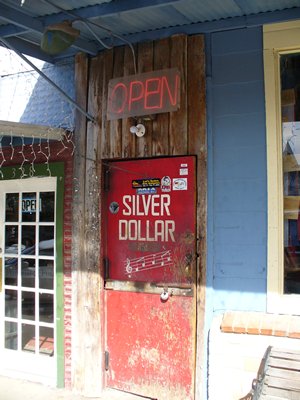 |
Silver Dollar
door
Photo courtesy Byron
Browne, December 2007 |
One
spot that had been open during our first visit and one which we had
not ventured into at that time was the Silver Dollar Saloon. The sign
out front read open just as it had on the previous Sunday; it became
our first stop. Maybe I shouldn’t mention that I am always drawn to
such places. The neon signs (lit no matter what the time of day),
the oversized, paint peeling, wooden door, coupled with the relative,
physical obscurity usually gives the place just enough mystery to
pull me in. (the Silver Dollar is located on the main street in Bandera.
However, the front door-yes, there’s a back door-is hiding out in
the open, sandwiched between two larger businesses. The entrance appears
to be some sort of storage space for one of the other two stores;
the sign out front, very possibly a relic.) The Broken Spoke in Austin
and the Longhorn Ballroom in Dallas,
hold the same sort of appeal for me. And, just as with these other
saloons, the Silver Dollar is extraordinary on account of both its
age and earned fame.
The Silver Dollar Saloon is subterranean. In retrospect, it should
be. The staircase, just a few feet inside the door, leads to an earlier
time- each step a few years. The sawdust on the floor in front of
the band’s stage is the consistency of the sort one would pull together
from under a workhorse, not the bottled powder that many honkytonks
use simultaneously for the floor and shuffleboard lane. The tables
here are “family-style” (I like “neighbor maker”), the long banquet
type with 12-15 chairs at each. Like it or not, on a Saturday night,
you’re sitting next to several people you didn’t ride in with.
As we entered the bar, I noticed the place was deserted except for
a smaller table in the back, in front of the fireplace. Like the sign,
the fireplace was lit and the five men sitting in front of it made
frequent comments on how nice it felt and how cold it was outside
(the temperature was in the 40s). There was something about the fire
that put both my wife and me at ease immediately and although the
young woman tending bar was a little bewildered by our order of just
water and a diet coke (I think I redeemed myself a while later asking
for cigarette change), all those in the bar quickly had the same effect
on us as the fire. We settled onto our bar stools and were soon disregarded
regulars.
We took pictures of the bar’s interior while half listening to a conversation
regarding Spanish grammar (“it’s amigo if it’s a guy, amiga
if it’s a girl.” “You sure?” “Yep. Positive.” “And it means friend?”
“Uh-huh.”) which my wife, a native Spanish speaker and teacher of
the same, found particularly charming. When we began to leave, after
about half an hour, everyone wished us good luck and the sincerity
in their voices was clear and genuine.
We walked to the Bandera Visitor Center next and found more pamphlets
and information on the area than we could ever use. Taking the literature
across the street, we found a table at the OST restaurant and ordered
lunch. The meal was better than the one Sunday had been but, I was
disappointed that they did not serve biscuits after 11:00 a.m. Noticing
that we were close to “The second-oldest Polish catholic church in
Texas”, we paid for our lunch at the register and began our westward
walk. A cloudy, cool, windless afternoon made the walk of a few blocks
even more enjoyable than it might have been otherwise. |
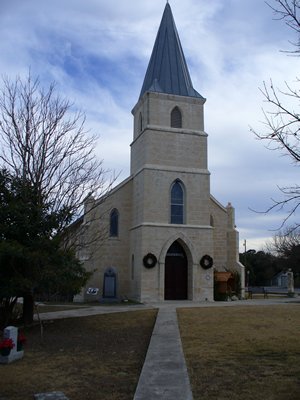 |
| St.
Stanislaus Catholic Church, built in 1876, is not too large a building,
by church standards, however, the entire complex does take up an entire
block. Much of the vicinity is taken up by the catholic cemetery-
an historical site by itself. Also on site, now a part of the church’s
school, is the convent for the few sisters who helped administer the
catholic community. I couldn’t help but imagine the inherent problems
these immigrants must have faced. Nevertheless, there certainly must
have been some fraternal reciprocity with all the neighboring German
communities. Still, I have always been awed by the courage these people
illustrated by making such a bold migration to a region so foreign,
relatively distant even from other immigrant populations. The pamphlets
we read stated that the Polish community was, initially, involved
in the production of roof shingles made from the ubiquitous cypress
trees- a trade that my father had told me was one of the main reasons
for Bandera’s
founding, another, the fact that the town was the beginning point
for northward cattle drives in the 19th and early 20th centuries.
I was reassured that, at least, these Polish immigrants had had a
common gathering spot. |
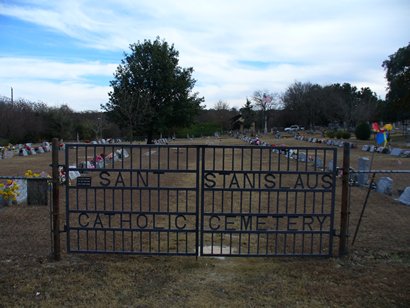 |
|
We wandered
the church grounds for several minutes, found the front door open,
as it should be, and took a seat inside. The nave was empty but,
still brightly lit. It smelled of burning candles. The interior
is expansive, has pale-colored walls highlighted by reds and natural
brown. The ceiling accents the rest of the interior with a pale
blue hue- the heavens, of course, opened for the congregation. The
walls are decorated not only with the omnipresent ‘Stations of the
Cross’ but also hold many paintings, depicting various biblical
and saint’s stories. Several of these paintings are created directly
onto the walls, like frescoes, and reminded me of the Greek Orthodox
churches I saw a few years ago.
Walking back to the town’s center was a delight. Not only was the
weather still perfect but people had begun arriving home and waved
to us as we passed their houses. My wife was pleased to see a number
of roosters and chickens bouncing through some yards; she had raised
a few as a child in Puerto Rico.
Our
final stop that day was to ‘Polly’s Chapel’. This small sanctuary
was built, by hand, by José Policarpo Rodriguez, a Mexican immigrant
turned army scout turned Methodist preacher who determined, in 1882,
that the town of Polly, Texas, then around 300 people, needed this
church. Located off highway 16 about six miles east of town we had
to double back since I missed the turn the first time. The road
to the chapel is called “Privilege Creek” and runs off of a street
named ‘Bear Creek Road’ according to the Bandera county map we acquired
from the visitor’s bureau. If you come in from the east you will
see a large white marker indicating the road and chapel. If you,
like us, are leaving town, all you can make out is the blank, back
of the sign. (That’s my excuse.)
If you’re making the journey (it should be described as nothing
short of that) just remember that you are probably going the right
direction and keep following the small, hand-made signs for a few
miles. The one lane paved road crosses a couple of draws before
it becomes dirt and rock and stays this way until you reach the
church. As with so many Texas destinations, the chapel really is
“just around the bend.”
|
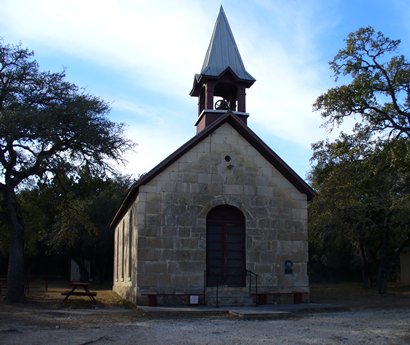 |
Polly’s Chapel
is such a unique spot that I’ll resist trying to describe it. I could
never do it justice. The chapel is open most days and in fact, there
is a flyer in doors describing who to call for events there.
Like the town of Bandera,
this little church in the woods is best described by each individual
who visits. However, it is a blessing that it has been allowed to
stand for these past 120 years but, that is the spirit of this community.
There are not too many locations where, as you eat a chicken fried
steak, you can see a thirty year old pick-up truck pulling a load
of hay, followed by a small fleet of motorcycles followed by a new
Hummer. There are many residents of Bandera
who bite their lips while enduring the four raucous motorcycle rallies
each year. A few others will roll their eyes as the “winter Texans”
roll their RVs into town every October. Nevertheless, this community
welcomes them all and is eager to offer their evidence of historical
Texas. As well they should-they not only have the past in hand but,
they are preserving it as well as anyone could.
© Byron
Browne
January 31, 2008 |
| Texas
Escapes, in its purpose to preserve historic, endangered and vanishing
Texas, asks that anyone wishing to share their local history, stories,
landmarks and vintage or recent photos, please contact
us. |
|
|
